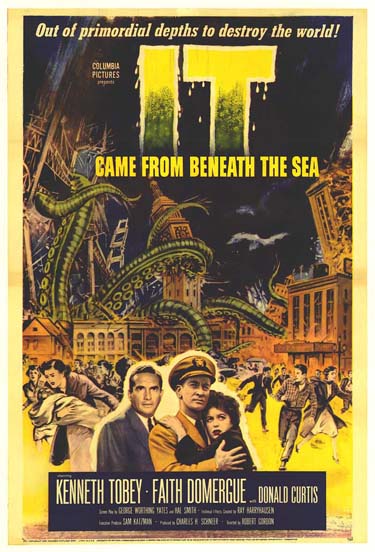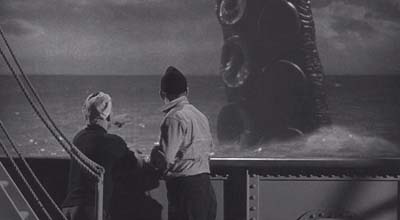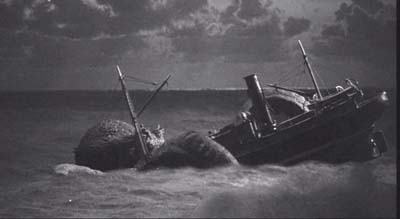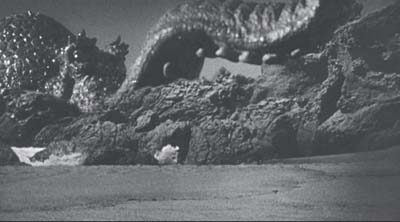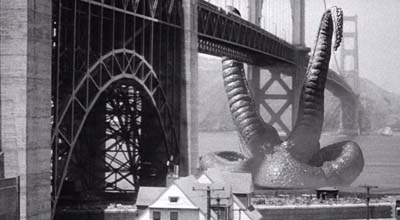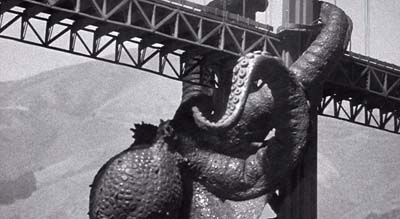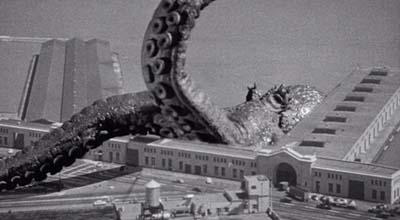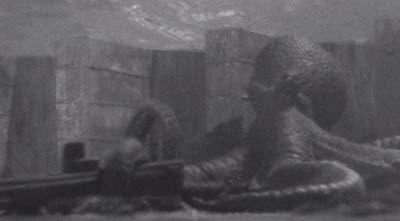When I (somewhat) recently reviewed Tarkan vs. the Vikings, I made much of the fact that it featured a GIANT INFLATABLE RUBBER OCTOPUS!!!! I posed at the time the query, “Has there ever been a movie, ever, that wouldn’t be improved by such a thing?”* Oddly, Turner Classic Movies helped answer this question recently when they playfully ran a skein of films featuring such beasties.
[*Actually, the weird thing was that I was actually surprised by the flood of enthusiasm from others on this topic. Gee, visitors to a b-movie site also prove to love giant rubber octopuses. What a shock.]I have to say, this sort of outright movie geekiness is the main reason I’m falling in love with TCM. Anyone can showcase classics like, oh, The Treasure of Sierra Madre. However, it’s the endless parade of utterly fun obscurities they offer that really sets them apart and makes them such a valuable resource. That they have people who think it’s a great idea to schedule a day full of Guy Kibbee movies, or spend an entire Friday night showing flicks featuring killer octopi…well, that’s what’s earning the increasingly deep affection I feel for the channel.
The first film they featured that night was, inevitably, It Came from Beneath the Sea. Actually, this felt like kind of a cheat. This was a bit of a classic and pretty well known (in its genre, anyway), and actually revolves around a giant octopus. I kind of liked the other movies better, which answered my question not by starring giant octopi, but by proving that indeed, any movie is improved by even a spot appearance of such a thing.
More importantly, as long-time Jabootu correspondent Sandra pointed out, “The monster in ICFBTS is NOT an octopus, as it has only six tentacles :-D. I think it’s a sexapus, but Gary [Sandra’s hubbie] claims it’s a hexapus.” This is famously true. Created by stop animation master Ray Harryhausen, the film’s typically modest budget didn’t allow for the full eight tentacles, which cost, or so we are generally told, ten grand per to animate.
Still and all, it seems churlish to exclude the film on that count. (Or the fact, for that matter, that it offers the evening’s only non-inflatable cephalopod.) After all, it’s not Harryhausen’s fault that he was so poorly funded. For consistency’s sake, we’ll assume his beastie started out as a regular octopus, and that the atomic mutation process which embiggened it also fused some of its tentacles together. And actually, the film does feature a cameo appearance by a real octopus, albeit one of normal proportions.
The ’50s, of course, remain the golden age of the science-fiction movie. Such films were cranked out by the hundreds, from big budget studio ‘A’ films like Forbidden Planet to shoestring cheapies like The Phantom from the Ocean Floor. Given the fecundity of the genre at that time, and the resources often devoted to them, unsurprisingly quite a few pictures from that era are just great films, sci-fi or not. At the other end of the bell curve, admittedly the more heavily populated end, are a number of simply dreadful (if generally still fun) efforts made by guys whose only interest was making a quick buck.
By definition, however, the vast majority of the decades’ sci-fi films fell within the middle regions of the curve. Most were highly formulaic programmers, deviating little from the general mass. ’50s sci-fi films were most often silly, short, terse, naïve, scientifically dubious, sexist (albeit also progressive; you have to take into account how they treated woman compared to earlier and then contemporary films, not just later ones), and, most importantly, fun.
Given this large, otherwise largely undifferentiated mass, the element that most often raised one film above the other was how cool its monster was. The Giant Claw and Kronos are each essentially generic ’50s sci-fi movies, down to both starring perennial sci-fi stiff Jeff Morrow. Kronos comes off as a markedly better effort, however, mostly because its monster (an energy drinking giant robot) is quite cool, both in conception and execution, whereas The Giant Claw‘s is quite possibly the decade’s most laughable menace.*
[*Indeed, the latter creature is so legendarily risible that it ironically has, among the cognoscenti, won its film far more abiding fame and certainly affection than the objectively far better Kronos.]So while It Came Beneath the Sea started with the advantage of being a studio film (Columbia), with a comparatively decent (if still rather tight) budget and the always appreciated familiar faces in its cast (Kenneth Tobey and Faith Domergue), it remains in most departments a dreary, threadbare affair. Even more than most such flicks, it suffers whenever the monster is offscreen. Luckily, the objectively small amount of monster is well distributed, offering several short yet potent set-pieces well sprinkled throughout the film’s 79 minute running time.
And, of course, ‘It’ was the creation of the beloved Ray Harryhausen, a man capable of elevating any film he touched into instant classic status. (Well, OK, there was Clash of the Titans. But still…) Following in the footsteps of his mentor, Willis “King Kong” O’Brien, Harryhausen hit the ground running in the ’50s, creating a series of monsters who remain beloved by fans to this day: The Rhedosaurus, the Ymir, the archetypical movie flying saucers, and the Cyclops and Dragon as featured in The 7th Voyage of Sinbad. All this, mind you, in just five years.
By dint of its nature, the ‘Pus in It Came Beneath the Sea easily exhibits the least amount of personality of any of Harryhausen’s creations. Don’t get me wrong, its sequences provide tons of nougaty monster goodness, and because of this the film remains the best ‘sea monster’ movie ever.* Still, there’s a reason ‘It’ is probably the least loved of Harryhausen’s creations. It’s entirely lacking in personality, and remains probably the sole monster Harryhausen ever provided whose demise provokes not even an inkling of pathos.
[*Barring, of course, Jaws for those who consider it one.]Being a generic ’50s sci-fi outing, we kick things off with the Obligatory Portentous Narrator blabbing over a slab of budget-efficient stock footage. The Topic du Jour is the development of the atomic sub, which naturally will play a big part in the film both directly and indirectly. As an example of American might, we are told, it was unparalleled. “The mind of Man had thought of everything,” we are assured, “except that which was beyond his comprehension.” Umh, well, yeah. This sort of thing remained a problem, as indicated by this exchange from 1979’s killer bee epic The Swarm:
Nuclear Power Plant Manager: “Billions of dollars have been spent to make these nuclear plants safe. Fail-safe! The odds against anything going wrong are astronomical, Doctor!”
Warning Scientist: “I appreciate that, Doctor. But let me ask you. In all your fail-safe techniques, is there a provision for an attack by killer bees?!”
Cue credits and, I must admit, a rather flavorless and annoying bombastic score. Even so, the roiling ‘seas’ the credits play over are a nice piece of imagery. And it’s always fun for the genre aficionado to watch the credits. While this film is short of familiar names amongst the supporting cast—no William Schallerts or Morris Ankrums here—there are several among the production end of things, including Harryhausen’s perennial producer Charles Schneer, screenwriter George “Them!” Worthing Yates, and especially Executive Producer Sam Katzman.
Since the opening Narration didn’t fully address the Threatening Mysteries of the Universe (seriously, its like they made these movies off a checklist), we now get a rather redundant text crawl—in Spooky Font, of course—to take care of the matter. “FOR CENTURIES THE MIND OF MAN HAS LEARNED COMPARITIVILY LITTLE OF THE MYSTERIES IN THE HEAVENS ABOVE—OR IN THE SEAS BELOW. SINCE THE COMING OF THE ATOMIC AGE, MAN’S KNOWLEDGE HAS SO INCREASED THAT ANY UPHEAVAL OF NATURE WOULD NOT BE BEYOND HIS BELIEF.” If you say so.
We open in a reported prototype nuclear sub, and to be fair the interior sets are realistically tiny. Moreover, they’re sufficiently elaborate that one can safely assume that one main impetus for making this particular film was that they had these sets left over from some other, more expensive production and wanted to get their money’s worth out of them. That’s unconfirmed but seems likely, especially given that legendary skinflint Sam Katzman oversaw the production.
The boat’s crew, under Cmdr. Pete Mathews (the ever reliable and always welcome Kenneth Tobey) is putting their spiffy new sub through its paces. This segues into a longish intro scene. This, per usual in ’50s monster movies, is played to establish a note of mystery, albeit one neutralized for movie audiences by the film posters garishly displaying whatever beastie was currently offered.
Something huge is spotted on sonar, begins pursuing their boat, and finally catches it. This latter situation is played much like your traditional depth-bombing scene, although sadly to rather less effect. After all, in a depth-bomb scene, you get explosions and such. Here, not so much.
Instead, the hoped-for tenseness is meant to result from the crew registering a disturbing amount of radiation emanating from the Whatsit. Their vessel eventually escapes—given the relative sizes of the ‘Pus and the sub seen later, this seems retroactively highly unlikely—and the mystery continues. This element is heightened (again, except for that who saw the film’s trailer or poster) when, as repairs to the sub are subsequently made, they find a large, rubbery barrel-like object wedged in the boat’s plates.
As this movie is nearly a flat-out remake of Beast from 20,000 Fathoms, it makes sense to compare it to that film. Sadly, this process accrues little credit to the latter film. It Came’s long opening scene, shot entirely in cramped submarine sets and with the monster off-camera throughout, is sadly lackluster compared to the action-packed North Pole opening of Beast. That film opened with polar blizzards, A-bomb tests, fatal misadventures, and finally a brief but exciting glimpse of the monster. Here, the most interesting part of the opening remains those storm-roiled waters churning away under the credits.
Following the in steps of Them!, which all these movies did, the befuddled Navy sends the evidence to Scientists. In this case, oceanographic pros Dr. John Carter (Donald Curtis) and, inevitable, the pneumatic Prof. Lesley Joyce (genre pro Faith Domergue). Unlike the Profs. Medford in Them!, neither of these characters are particularly interesting. Worse, things take a quick dive when Carter, Joyce and Mathews enter into what may well be the single most insufferable romantic triangle of any ’50s sci-fi flick, which is saying something.
Even if you somehow didn’t immediately realize that the stalwart Mathews was a shoe-in, the fact that Joyce lamely champions Carter as “brilliant” pretty much settles things. And while patent Other Guys like Carter often relinquish the heroine with little more than a gallant shrug, Carter in particular never really seems overly interested in Joyce at all. Sadly, the viewer remains the least interested party of all, groaning during the interminable scenes of the three having dinner together or whatnot and wishing the titular beastie would get back to business.
Just as numbing are the ‘science’ scenes, as the Navy dragoons for this incredibly urgent and vital project a vast team of both scientist listed above. (This pretty much being a standard, and quite economical, trope for cheapie sci-fiers.) The pair supposedly toils away for several weeks to discover from whence came the rubbery barrel thingee. This artifact is examined by the cast as it rests inside a windowed case, one that just happens to be entirely opaque on the audience’s side. This conveniently allowed them to avoid building an actual prop for the thing.
Moreover, when we actually see Carter and Joyce at ‘work,’ it consists of Carter looking in a microscope and Joyce—I swear—mucking around in a wee goldfish tank with a small skimming net. Meanwhile, Mathews (who, I remind you, is the U.S. Navy’s top submarine captain) sits at a nearby desk, chain smokes, fields the occasional phone calls and macks on Joyce when the mood strikes.
This is all pretty deadly stuff. Finally, though, at nearly the half hour mark we get the goods. This involves a terrific sequence wherein a tramp steamer is attacked and finally dragged down by the ‘Pus. Which, I should note, turns out to be not merely ‘giant,’ but freakin’ huge. Although it’s been a good while coming, this stuff totally pays off. And with the entirely film only running about 77 minutes, the ‘Pus will pops up on a regular basis from here on out.
At the same time, this scene alone pretty much seals the deal in terms of making this the greatest sea monster ever. There have been plenty of movies, especially since Jaws, in which monsters eat swimmers and such. And lots of films feature a monster sinking a boat or two. However, a proper sea monster is going to wreak havoc on a grand scale. The ‘Pus here doesn’t just capsize a catamaran or motorboat, but pulls down a pretty sizable ship. Now we’re talking.*
[*Every couple of years, someone mulls making a film adaptation of Meg, a novel about a prehistoric, giant shark set loose on the modern world. Should this ever occur, they might want to grab a few pointers from this creaky old flick. If a giant monster isn’t committing joyfully outsized mayhem, what’s the point?]Sadly, then it’s back to the human characters. First we get the previously indicated dinner party with our three leads. then the film rotely borrows another page from The Beast from 20,000 Fathoms. In that film, the hero is the first to see the rampaging dinosaur stalking the Artic wastes. After he reports the sighting, though, he finds that he is considered a psychiatric case. Here the same thing happens, but involving the surviving crewmen.
Sure enough, the first sailor dutifully details what happened, only to get ushered to a shrink. Once the remaining crew sees how things are going, they refuse to acknowledge what they saw. This leads to a depressingly silly scene where Joyce vamps one of the sailors to get him to give her the straight dope. Listening in secret over an intercom, Navy brass finally accepts the scientists’ theory about the giant ‘Pus.
At this point, the U.S. Navy pretty much just unilaterally shuts down all shipping lanes worldwide. (!!!!) Why they wouldn’t just reveal the real story isn’t explained. And since this was made in the ’50s, the film doesn’t bat an eye about any of this. In any case, we see a destroyer laying depth charges, leading to the hilarious conjecture that they are bombing vast swathes of the various oceans in the hope that maybe they’ll just happen to kill the ‘Pus.
Meanwhile, we get the typical lectures from the Scientists regarding how the authorities DON’T REALIZE WHAT THEY’RE DEALING WITH. Amazingly, this doesn’t entail them showing a room of government bigwigs a reel of octopi stock footage indicating how savage the species is. Instead—I swear—to illustrate how fast the ‘Pus can move, they blow up a balloon and then let it go farting through the air. Wow, that certainly brings it all crashing home.
Taking an umpteenth page from Them!, although in the film’s trademark threadbare fashion, the principals then sift through a small and remarkably bland stack of unexplained phenomena reports. “Any one of these may well be the clue we’re seeking!” Carter gamely asserts. He goes off to investigate an out of touch weather station. Afterward, the panel receives a last report detailing several missing persons and a car found overturned on a beach. Mathews and Joyce head out there.
The local yokel Deputy laughs off their questions about sea monster sightings, but Joyce finds giant sucker marks on the beachfront. Well, that makes total sense. I’m sure a gigantic, multi deca-ton creature is lazing around this area, sustaining itself on two or three beachcombers a week. At this, Mathews radios to have Carter join them. He does, later that evening, and is brought to the beach by the Local Yokel.
Meanwhile, Mathews gets all makey-outy with Joyce again. She eventually pushes him away, but we can tell he gives her a case of the hot pants. Then they join Carter, who at this point is her fiancée (which makes Mathews kind of a colossal dick, and Joyce kind of a slut) and Deputy McWisenheimer.
Following a particularly piquant display of sexism on Mathews’ part—albeit he seems to learn his lesson quickly—the Deputy inevitably pays for his boorish scoffery in the most obvious fashion possible. Why the ‘Pus didn’t attack either of our leads, who have spent the entire day diving and swimming out in the cove’s actual waters, is entirely and all too patently a matter of script contrivance. Meanwhile, occurring after another twenty minute wait, this sequence proves a bit of a letdown from the ‘Pus’ previous shipwrecking rampage. Even so, with less than a half hour of movie remaining, Ol’ Sexty gets heavy play from here on out.
So our leads vamoose, and the Navy more or less closes down the entire western seaboard. More than that, actually, since we’re talking the waters “from Panama to the Arctic Circle” are mined and patrolled by Navy ships. Ah, those were the days.
Next we get the mandatory press conference scene. Again, the budget shows itself via the exactly half dozen extras they hired to play the reporters. I don’t know, this seems sort of a big story. The big preventions gone over (three guesses why) involve those around San Francisco, which include anti-sub netting spanning the bay entrance, which has been rigged to take an electrical charge if need be.
Meanwhile, Carter is up in an airplane apparently flying over 40% of the Pacific Ocean, looking for the beast. Yes, that’s reasonable. Oops, my bad. The entire stretch of waters have been baited “with dead sharks” (what, the entire western seaboard?!) and patrolled by hundreds of plane. So, fool proof. By the way, the Navy is now conducting about the biggest operation in its history, and one of the entire two scientific consultants it brought in has nothing better to do then fly around and hope to spot the monster at random? Whatever.
They also set up (rather unconvincingly) that the beast must be killed in one attack, and has but a single vulnerable spot—because, you know, you just couldn’t blow the hell out of it with depth charges or torpedoes—which is naturally right between its eyes. They remain cagey about their exact attack strategy, though. After all, they wouldn’t want the ‘Pus to read all of their plans in the papers. Carter also advises Joyce, attending the press conference, to take the (six) reporters down to the Navy Yard and show them their specialized attack weapon. Again, this is the sort of stuff they need their sole pair of scientific experts to be doing?
Anyhoo. (Remember when I said the monster wasn’t offscreen all that long during the last half hour? I didn’t say it doesn’t feel like it.) So Joyce and the (six) reporters dutifully troop down to the dock, and example…a torpedo. Wow, that’s something.
Ah, but it is, you see. For instance, this exact torpedo is “jet-propelled.” Apparently this entirely new torpedo technology was whipped up overnight—there’s American can-do spirit for you—at Joyce’s direction, after she spend the previous afternoon talking to whaling veterans. So the torpedo is basically a jet-propelled harpoon, albeit (wait for it) one with a high explosive warhead. Like a harpoon, this torpedo is designed to penetrate and lodge in the monster’s body, following which it can be remotely detonated.
Blah, blah. As usual, this is getting away from me. Anymore, everybody expects the beast to end up homing in on San Francisco, although I didn’t catch the part where they said why. (The real reason? The Beast from 20,000 Fathoms zeroed in on New York City, because that was coincidentally its old spawning grounds. And as noted, this film pretty much is just a remake of Beast.)
The “first line of defense” is a screen of remotely detonated mines. These fail to dissuade the beast from heading to the city—which is pretty silly—and as the sequence opts not to actually show up the ‘Pus during all the explosions, it is pretty dull. In any case, I’m not sure why they’d want to chase the thing back out to open sea, where its escape would seem inevitable, but there you go.
The ‘Pus ends up right under the Golden Gate Bridge, which as a landmark naturally draws the attention of any agent of mass destruction, whether terrestrial or alien in nature. So they decide to throw on the electrical netting. Sadly, this doesn’t destroy the creature, but merely pisses it off and drives it from the water. It drags itself up one of the main support columns of the bridge, and proceeds to tear the structure apart in pretty spectacular fashion.
This sequence also offers a rare bright spot in the human action. Realizing that the electricity is what is causing the ‘Pus to go on the warpath, Carter drives onto the evacuated bridge to turn the juice off. Sadly, his car is wrecked by an errant tentacle before he can safely retreat. Coming to the rescue is Mathews, who drives after him and gets him to safety. (Tobey’s little smile following this, as if saying, “Man, I can’t believe we got out of that alive,” is a typically nice acting moment from a seasoned pro.) A hysterical Joyce embraces Carter, but then flings herself into Mathew’s arms. And so the romantic baton has been passed. Ho hum.
Shortly after this, the ‘Pus pulls itself up onto the Ferry Building and begins sending its ridiculously gigantic tentacles through the city streets. Various bystanders (often running in all different directions, an old Sam Katzman trick so that he could have the monster supposedly positioned wherever he liked) fall under its suckers, implicitly to be eaten, although obviously we don’t see anything like that. Then the Army counterattacks with flamethrowers in a sequence that at least is about a million times more logical than the similar bit in The Swarm.
Driver back into the water, the beast is in position to be attacked by Mathews’ sub. (Oddly, I don’t think this is ever given a name.) They get the torpedo lodged in the beast’s head, but the ‘Pus grabs the sub in retaliation. Which, I must say, is a simply awesome bit of imagery. Anyway, Mathews ends up incapacitated out in the water while trying to free the sub (yeah, that’s a job the Captain would take on personally). This gives Carter the chance to settle the score, thus proving that he’s also a Read Man, even if he’s a pantywaist scientist.
By the way, this bit is pretty hilarious in a classic Star Trek fashion. First, Mathews pulls a Kirk and takes on the highly dangerous mission personally. Then, when he doesn’t return and the sub is still caught, the XO decides that it’s his turn. And so it would have gone, presumably, man after man. If you ever wondered how a Seaman Recruit would end up in charge of a nuclear submarine, well, there you go.
However, this potentially endless cycle is broken when Carter demands to take the XO’s place. As a Scientist!, he argues, only he knows where the ‘Pus is vulnerable. So saying, he dons a scuba suit, grabs a ‘harpoon gun’ (all nuclear subs carry them) and heads out into the water. Following a truly awful traveling matte in which Carter turns entirely transparent, he puts a harpoon right in the beast’s eye. Gee, good thing he has such intimate knowledge of octopus physiology. Who else would have thought of attacking its eye.
The sub is released (rather than crushed by the ‘Pus as it spasms, which seems vastly more likely), the craft backs off to a safe distance and sets off the torpedo, blowing up the beast—and setting up the end of Jaws many years later—and then, big surprise, Carter and Mathews are found safely bobbing on the surface of the water. Then another dinner party, just long enough to establish that Joyce has opted for the manly Mathews. Carter looks on bemused, although we can’t even tell if she had informed him that she’s breaking up with him, and end picture.
As noted, the human drama scenes are so lame that they can’t even be saved by what is, for this sort of picture, an ‘A’ cast. Although a popular general character actor, Kenneth Tobey is most famous (and rightly so) as the hero of The Thing from Another World, a role that locked him into military parts in sci-fi films. He played a supporting role as such in the earlier The Beast from 20,000 Fathoms, and takes center stage here. He continued to work steadily through the ’90s, including several Joe Dante movies and the affectionate low-budget spoof The Naked Monster. Mr. Tobey previously appeared in these pages by dint of his supporting role in Billy Jack. However, he has too many credits to really explore here. The curious may check out his extensive filmography on the IMDB. Mr. Tobey passed away in 2002.
Faith Demergue starred in three sci-fers in 1955, playing the snakewoman in Cult of the Cobra as well as the heroines of this film and This Island Earth. The next year she starred in The Atomic Man, and then segued into more normal films and the obligatory TV guest work. In 1965 she returned to sci-fi pictures, filming American language scenes to be cut into a Russian space opera bought by Roger Corman. Coincidentally, watch for a review of that film, Voyage to the Prehistoric Planet, in the near future. (See, Katherine, I haven’t forgotten! Really!) Ms. Demergue continued to work through the early ’70s, ending up in a series of nondescript horror films. She passed away in 1999.

OCTOPUS CONTENT: A+, obviously. As you’d imagine, if this is the greatest sea monster movie ever, then by default it’s also the greatest giant octopus movie ever. However, considering that its only direct competition is the incredibly dull Italian Jaws knock-off Tentacles (1977), that’s damning our feature with microscopically faint praise.
Not only is Tentacles even more lackluster than the non-Harryhausen bits of It Came Beneath the Sea, which is saying something, but its special effects are incredibly poor compared to Harryhausen’s film. Considering the latter had the advantage of over two entire decades of special effects advances, its efforts in this regard is truly pathetic. The incredibly brief ‘effects’ shots in Tentacles largely consist of a mock octopus being shoved so as to drift into camera range as a way of simulating movement, as shot from below so that it appears (for a precious few seconds) to be menacing some supremely obvious toy boats.
Meanwhile, recent years have seen a small number of giant squid movies—because those are somewhat more realistic, yawn—but even throwing those into the mix, this is hand’s down the greatest giant cephalopod movie ever. I guess I could mark it down for the mixing tentacles, but that would be churlish. Harryhausen’s genius is the only thing that makes this otherwise dreary film at all watchable. Even the always reliable Kenneth Tobey can’t do much with the ‘human drama’ stuff.
Again, though, it should be noted that the film ‘cheats’ a bit by making the Sextapus the movie’s focal point. While the glorious GIANT INFLATABLE RUBBER OCTOPUS!!!! in Tarkan vs. the Vikings also makes regular appearances—although with eventually diminishing effect, which definitely isn’t the case here—in the remaining films we’ll be studying the octopus will being rather more realistically-sized (still overly large, perhaps, but not to such a fantastical degree) and pop up for one major sequence only. So for several reasons, including the non-balloon like nature of Mr. Harryhausen’s monster, comparing those features to our present subject is entirely an apples and oranges affair.
All the attack scenes here, no matter how brief, are well worth watching. (The short beach scene where the Deputy gets kacked is just barely so, however.) Of the major sequences, the ‘Pus attacking the tramp steamer is my favorite—sea monsters, after all, should prey on ships first and foremost—while the rampage at the Golden Gate Bride is the most spectacular and famous scene. Next I’d go with the underwater scene where it tussles with the sub, because that’s just awesome stuff, and then the admitted show-stopping attack on the city docks. I guess my main quibble with that latter bit is the aforementioned stealing from The Beast From 20,000 Fathoms.
The movie is out on a newer, remastered DVD presentation, which is reportedly quite spiffy. There are several extras, including a colorized version of the film personally overseen by Mr. Harryhausen and given his approval. I wouldn’t think that would add anything useful, but different strokes for different folks, and it has to be said that colorization technology has gotten significantly better since the idea was first introduced.
THE OCTOPUS CHRONICLES PART 2 TO FOLLOW SOON…
A special Jabootu thanks to Roger Hylton and Shane Thielen, both of who went to the hassle of recording the movies on Turner Classics that night and sending me copies thereof. Thanks, guys!!

